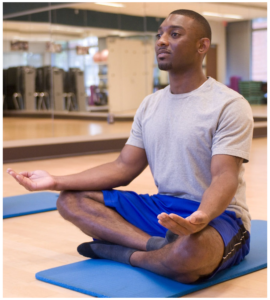My yoga teacher often calls Warrior II the “stuck-in-traffic” pose. This standing posture encourages strength, stability, and focus. It has a way of redirecting us away from distractions and discomfort, a helpful skill for dealing with “road rage.” This got me thinking. If yoga can help us become better drivers, could yoga also help us create better online courses?
At VirtualSC, we build online courses using collaborative design teams. Since teamwork can cause “traffic jams,” we are continually working to improve our course-building process and how we work together.
The author Stephen King calls a metaphor a kind of miracle because it can change the way we think or talk about something. So I began using yoga as a metaphor for instructional design. Here’s how: I compare how we build quality online courses to the sequence of a yoga class.
#1: Community
Often a yoga class starts with easy seat, a simple cross-legged position. While seated, yogis (people who practice yoga) set an intention for their practice. It helps the class come together and each person to be fully present.
We hold a kickoff meeting for new course projects at our summer conference. We invite design teams to attend the session. During the meeting, we set the expectations for design teams. We define the requirements for a completed course, clarify roles for design teams, and review the course project calendar. This is how we come together.
#2: Integration
Next, a yoga class begins to match movement with breath using cat-cow pose. This gentle flow stretches the body and prepares for other, more energetic activity. It helps the body get started.
We use the “Working on a VSC Design Team” course to orient design teams to our process for course building and quality control. The course includes two projects similar to what design teams do to create a new online course. We start our process by practicing.
#3: Energy
Sun salutation is a sequence of poses that create energy, increase blood flow, and strengthen the body. It is where the work of yoga occurs in the body and mind.
Like sun salutation, we repeat cycles of creation and review throughout our course-building process. We plan the course, workshop the plan, then revise it. We develop each unit, then review and revise it. By repeating these cycles, quality becomes our habit.
 #4: Stability
#4: Stability
Yoga is about balance, and most balance poses, like tree pose, require two sets of muscles to provide stability for the body. Balance also impacts the grace we extend to ourselves and others. Chinese philosophy sees yin and yang as opposite but complementary forces that interact to make the whole greater than its parts–like the two sets of muscles in a stability pose.
For a course project, this idea suggests that when we disagree, we have the potential to create something better. Mark Twain said, “Continuous improvement is better than delayed perfection.” Perfectionists have trouble sharing their work and receiving constructive feedback without getting defensive. Within a design team, this can make the process of quality review difficult. But we must disagree skillfully, kindly, and productively.
#5: Reflection
At the end of class, yogis lay on the mat completely still, like a corpse, to renew both body and mind. This posture helps us to reflect on how the yoga practice has affected us.
When we finish a course project at VirtualSC, we update our documentation. For courses, this includes the syllabus, instructor resources, and standards alignment. For our process, this involves instructions, templates, and agendas. This reflection looks back on the process and allows us to capture lessons learned.
A yoga practice finishes with the Namaste gesture, bringing hands together at the heart. It serves as a symbol of gratitude and respect between yogis. As you finish this blog, I hope that the metaphor of yoga has had a positive effect on your ideas about creating quality online courses. Namaste.
Clay Alan Ham, Ph.D., PMP is an avid yogi. He serves as an instructional designer/project manager supporting teams in developing online courses for VirtualSC, a program of the South Carolina Department of Education. He regularly leads review teams for Quality Matters as a certified K-12 Master Reviewer. Clay received the 2019 Directors’ Award for Exceptional Service to Quality Matters for K-12.

